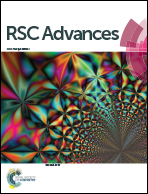Paste-type thin-film transistors based on self-supported chitosan membranes
Abstract
Chitosan is a most common biopolysaccharide and has been widely used for bio- or medical-materials. In this work, chitosan was prepared in the form of self-supported proton-conducting membranes with a high proton conductivity of 2.3 × 10−3 S cm−1 by protonic acid doping at room temperature. These chitosan-based self-supported membranes were then used as both flexible substrates and gate dielectrics for fabricating paste-type thin-film transistors (TFTs). The feature of these paste-type TFTs is that all the electrodes (gate/source/drain electrodes) and channels are located on the same one side of chitosan dielectric membranes, which is very convenient for TFTs to be transferred and stuck on various places in a wide variety of applications. Due to the huge lateral electric-double-layer (EDL) capacitive coupling induced by spatial movement of protons in chitosan-based proton-conducting membranes, these TFTs showed a low-voltage operation of only 1.5 V with a large field-effect mobility of 20.2 cm2 V−1 s−1. Furthermore, AND logic operation was also demonstrated on these TFTs. Our results indicate these chitosan-based paste-type TFTs have great potential for broadening their applications on wearable electronic products and biocompatible electronics.



 Please wait while we load your content...
Please wait while we load your content...